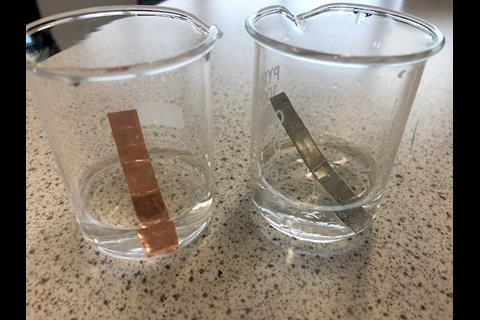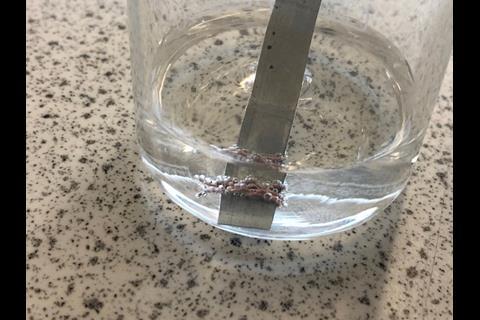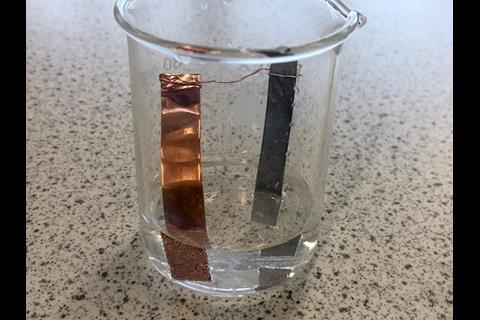Use these ideas, exercises and experiments to help your students get on top of this challenging topic

Redox chemistry plays an enormous part in our daily lives in today’s electronic world, particularly in the use of smartphones, which rely on the latest redox cell technology. The voltage of a cell or battery depends on several factors, including what the electrodes are made from and the substance used as the electrolyte. Today’s mobile phones have relatively small, light and amazingly powerful batteries, that make it possible to have enormous computing power in our pockets. Such contexts provide opportunities to explore the sustainability aspects of our increased use of many elements (see EuChemS periodic table indicating scarcity).
Redox chemistry plays an enormous part in our daily lives in today’s electronic world, particularly in the use of smartphones, which rely on the latest redox cell technology. The voltage of a cell or battery depends on several factors, including what the electrodes are made from and the substance used as the electrolyte. Today’s mobile phones have relatively small, light and amazingly powerful batteries, that make it possible to have enormous computing power in our pockets. Such contexts provide opportunities to explore the sustainability aspects of our increased use of many elements.
Of course, there are many other ways to put redox chemistry into everyday contexts: rusting and its prevention (the problem incurs massive costs); oxidising consumer products that bleach colour from hair or fabrics; and applications of antioxidants in food manufacture that prevent food spoiling.
What students need to know
To understand more advanced redox chemistry, students need to be secure in their pre-16 ideas about atoms, ions, chemical formulas and the links between these, as well as defining oxidation and reduction in terms of electron transfer. Here are some more advanced concepts:
- Writing half-equations (ion–electron half-equations) and balancing them where required.
- Oxidising agents accept electrons (so are reduced) and reducing agents donate electrons (so are oxidised).
- The many meanings for oxidation and reduction (see table).
- Elements have a specific oxidation number or particular oxidation state. Transition metals can have different oxidation states in their compounds.
- Disproportionation occurs when the same substance is oxidised and reduced simultaneously, for example Cl2 + H2 O → HOCl + HCl.
|
Oxidation |
Reduction |
|
Gain of oxygen |
Loss of oxygen |
|
Loss of electrons |
Gain of electrons |
|
Loss of hydrogen |
Gain of hydrogen |
|
Increase in O:H ratio |
Decrease in O:H ratio |
|
Increase in oxidation number |
Decrease in oxidation number |
Threshold concept
It’s all relative. Oxidation and reduction reactions take place simultaneously, but which of these reactions takes place for a particular substance depends on the other substance involved. For example, Fe2+ ions will be reduced when paired with zinc, yet Fe2+ can be oxidised if partnered with silver ions, or others lower down the electrochemical series.
Common misconceptions
- Writing chemical equations, and accurate formulas – subscripts, brackets and coefficients – can be tricky.
- Interpreting what is happening in the description of a redox reaction, to writing half-equations and understanding which ions are reacting, and which are not, can all be challenging for students.
- Students can struggle with the many and various meanings of oxidation and reduction (see table).
- The historical aspects of electricity and the terms anode and cathode can be terribly confusing, depending on their situation (electrolysis or electrochemical cell), as outlined in this article on reducing redox difficulties. Sticking to positive electrode and negative electrode labels clarifies definitions for students and avoids such difficulties (as some curriculum specifications already do).
Common misconceptions
- Writing chemical equations, and accurate formulas – subscripts, brackets and coefficients – can be tricky.
- Interpreting what is happening in the description of a redox reaction, to writing half-equations and understanding which ions are reacting, and which are not, can all be challenging for students.
- Students can struggle with the many and various meanings of oxidation and reduction (see table).
- The historical aspects of electricity and the terms anode and cathode can be terribly confusing, depending on their situation (electrolysis or electrochemical cell), as outlined in this article on reducing redox difficulties: rsc.li/3Ny2Ide. Sticking to positive electrode and negative electrode labels clarifies definitions for students and avoids such difficulties (as some curriculum specifications already do).
Where students go wrong
Oxidising and reducing agents are often muddled up. Students can find it hard to appreciate that an oxidising agent is itself reduced, while a reducing agent is oxidised. Making analogies can be helpful here (see Ideas for the classroom below).
Students often confuse the trends in oxidising power of the halogens with trends in the reducing power of the halide ions. Down the group from fluorine, halogens are less powerful oxidising agents, whereas going down this group, halide ions are more powerful reducing agents.
When presented with a redox reaction, students can find it tricky to spot the obvious change in an element without having to work out all the oxidation numbers. It’s helpful for your students to practise identifying ions to/from atoms, each side of the equation.
Ideas for the classroom
It is important to check and ensure students can correctly write the ions that are formed in chemical reactions. Some small-scale practical activities can help them to observe things in detail and check their understanding of underpinning ideas about ions in solution. For example, this diffusion experiment shows ions are formed and diffuse – they can move. This experiment is repeated exactly as before and then by adding nichrome wire electrodes (connected to 4.5–6V dc) into the solution, either side of the position where the yellow precipitate of lead iodide first appeared. Ask students to note and try to explain their observations.
The investigating reactivity activity can get students thinking about electron flow by careful observations with zinc and copper strips in dilute sulfuric acid. This works well as a slow practical where students set up each of the three simple steps, with whole class discussions after each step to draw out the ideas.
It is important to check and ensure students can correctly write the ions that are formed in chemical reactions. Some small-scale practical activities can help them to observe things in detail and check their understanding of underpinning ideas about ions in solution. For example, this diffusion experiment (rsc.li/38eBisz) shows ions are formed and diffuse – they can move. This experiment is repeated exactly as before and then by adding nichrome wire electrodes (connected to 4.5–6V dc) into the solution, either side of the position where the yellow precipitate of lead iodide first appeared. Ask students to note and try to explain their observations.
The investigating reactivity activity (rsc.li/3Ny2Ide) can get students thinking about electron flow by careful observations with zinc and copper strips in dilute sulfuric acid. This works well as a slow practical where students set up each of the three simple steps, with whole class discussions after each step to draw out the ideas.
Displacement reactions of various metals or metal ion solutions are popular activities, with students seeing the pattern, predicting the reactions that will take place and writing ion–electron half-equations. You could focus more attention on the halogens to highlight a similar scenario where displacement reactions of halogens can be carried out to show the trend for the halogens and solutions of their halide ions.
You can explore these ideas further by making electrochemical half-cells with a non-metal (for example, iodide ions with graphite electrodes) and halogen practice questions from Starters for 10. Building an electrochemical cell from two half-cells, one with an iron(III) salt and the other with potassium iodide, allows students to observe yellowish iodine being formed at the positive electrode.
Students find analogies to clarify the meaning and roles of oxidising/reducing agents helpful. For example, the word agent: a travel agent sets up the travel or holiday, but does not go on the trip. Or the analogy can be tailored to your students’ interests: a football agent will arrange for a player to transfer from one club to another, but the agent does not move with them. Another effective analogy from Tim Jolliff likens the best salesperson getting rid of their stock most easily to the best reducing agent giving away electrons.
Oxidation numbers from the Chemistry for the gifted and talented resources provides some excellent classroom activities, where students work out where some of the numbers come from. For example, LiAlH4 is a useful example in working out, based on electronegativities, that hydride is 1-, before viewing a typical list of rules.
Displacement reactions of various metals or metal ion solutions is a popular activity, with students seeing the pattern, predicting the reactions that will take place and writing ion–electron half-equations. You could focus more attention on the halogens to highlight a similar scenario where displacement reactions of halogens can be carried out to show the trend for the halogens and solutions of their halide ions.
You can explore these ideas further by making electrochemical half-cells (rsc.li/36xU5id) with a non-metal (for example, iodide ions with graphite electrodes) and halogen practice questions from Starters for 10 (rsc.li/3wP11lG). Building an electrochemical cell from two half-cells, one with an iron(III) salt and the other with potassium iodide, allows students to observe yellowish iodine being formed at the positive electrode.
Students find analogies to clarify the meaning and roles of oxidising/reducing agents helpful. For example, the word agent: a travel agent sets up the travel or holiday, but does not go on the trip. Or the analogy can be tailored to your students’ interests: a football agent will arrange for a player to transfer from one club to another, but the agent does not move with them. Another effective analogy from Tim Jolliff likens the best salesperson getting rid of their stock most easily to the best reducing agent giving away electrons.
Oxidation numbers from the Chemistry for the gifted and talented resources provides some excellent classroom activities, where students work out where some of the numbers come from (rsc.li/3Lsz2wg). For example, LiAlH4 is a useful example in working out, based on electronegativities, that hydride is 1-, before viewing a typical list of rules.
Assessment
In checking students’ understanding throughout this topic, ensure there is plenty of time to practise the various steps from writing ion–electron half-equations to balancing these and combining them. You will quickly see from students’ answers who has understood or who is struggling and needs more help. The Starters for 10 redox resource offers a range of question types and examples with the option of an editable worksheet and answer sheet.
In checking students’ understanding throughout this topic, ensure there is plenty of time to practise the various steps from writing ion–electron half-equations to balancing these and combining them. You will quickly see from students’ answers who has understood or who is struggling and needs more help. The Starters for 10 redox (rsc.li/3wQrMpM) resource offers a range of question types and examples with the option of an editable worksheet and answer sheet.
You can use small-scale practical activities, such as investigating redox reactions on a microscale, to observe redox reactions closely and think through what is happening, and then clarify ideas by writing corresponding equations.
Take-home points
- At the start of the topic, make sure your students have a good understanding of the basics of ions, solutions and how to write these before going further.
- Try to use practical activities to promote thinking and write equations for the processes observed.
- Provide lots of opportunities to practise ion–electron half-equations and redox equations.
- Frequently make links to other curriculum topics and real-world contexts that can strengthen understanding and increase retrieval practice, such as oxidation of alcohols and redox titrations (for example, vitamin C).
Morag Easson a Royal Society of Chemistry trainer and independent science education consultant












3 readers' comments